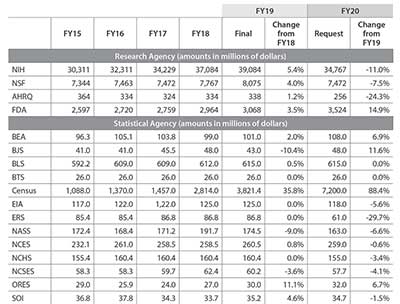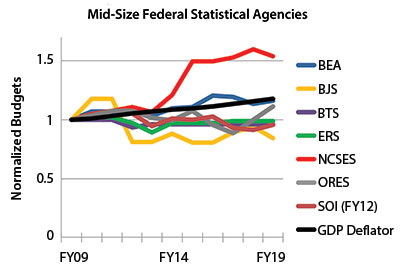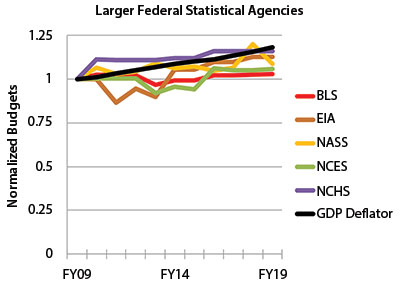FY19 Budget Finalized; FY20 Budget Deliberations Underway
Steve Pierson, ASA Director of Science Policy
Just before President Donald Trump’s FY20 budget request was released in March, the budget for the entire federal government was fully finalized after the longest government shutdown in US history. The highlights of the FY19 federal budget finalized in February include a four percent increase for the National Science Foundation (NSF) over the prior year and a 36 percent increase for the US Census Bureau as it ramps up for the 2020 Decennial Census.
As seen in Table 1, the budgets for the federal statistical agencies were generally flat, though the Bureau of Justice Statistics (BJS) was cut 10 percent. The 10 percent cut for the National Agricultural Statistics Service (NASS) was mostly a reflection of an increase in FY18 for its quinquennial Census of Agriculture.

Table 1. FY15–FY19 Budgets and FY20 Requests for NIH, NSF, AHRQ, FDA, and the 13 Primary Federal Statistical Agencies
The continued flat funding for many of the federal statistical agencies is concerning when one looks at their loss of purchasing power since FY09. As seen in figures 1 and 2, the majority of the 13 primary federal statistical agencies have lost purchasing power since FY09, several on the order of 15–20 percent.

Figure 1: The budgets of the seven mid-sized statistical agencies normalized to their FY09 levels, along with the GDP deflator to account for inflation. Budget restructuring for ERS in FY15 is accounted for in the graph to allow for comparison over this time period. One-time moving costs in FY16 for BEA area also omitted.

Figure 2: The budgets of five larger statistical agencies normalized to their FY09 level, along with the GDP deflator to account for inflation. Census is omitted because of the large changes in the decennial census cycle. Budget restructuring for NASS and NCHS in FY15 is accounted for in the graph to allow for comparison over this time period.
As one example, the Bureau of Labor Statistics (BLS) has lost $85 million in purchasing power since FY09. As a result, like other statistical agencies in a similar budget situation, BLS is challenged to keep up with changing dynamics of what it is tracking. For BLS, this means fully accounting for the changes in our workforce and economy due to the gig economy, AI, robotics, automation, and other factors. BLS also needs resources to modernize its programs to address declining response rates and take advantage of technological and methodological advances and big data, all of which could reduce respondent burden.
The president’s FY20 request is similar to past requests of this administration, proposing large cuts for the NSF, National Institutes of Health (NIH), and Agency for Healthcare Research and Quality (AHRQ) and modest cuts for many federal statistical agencies. There are a few notable exceptions. The budget requests an 88 percent increase for Census, a 7 percent increase for the Bureau of Economic Analysis (BEA), and a 12 percent increase for BJS.
The Census Project points out FY20 is $1 billion short of what Commerce Secretary Wilbur Ross said he would need to carry out the decennial census and possibly $2 billion short of what is needed overall (see https://bit.ly/2HhmHwr). The percent increase for the BEA would be used for its agency’s work to implement the Foundations of Evidence-Based Policymaking Act (FEPA), provide GDP info to Puerto Rico, and plan the proposed move of BLS to the Department of Commerce. The BJS request would restore BJS to its F18 level after a 10 percent cut in FY19.
The US Department of Agriculture (USDA) again proposes to slash the Economic Research Service (ERS) program budget, this time by 48 percent, through cuts to research and analysis for the following areas:
- Farm, conservation, and trade policy
- Food assistance, nutrition, and diet quality
- Rural economy and well-being
- Food safety
The cutting of the food and nutrition programs is particularly concerning because two-thirds of the USDA’s $140 billion budget goes to nutrition assistance programs. While it is unlikely Congress would approve such cuts, they are troubling because of how much they would undermine evidence-based policymaking for the key programs.
The USDA also has $16 million to fund its controversial relocation of the ERS outside of Washington, DC, that the ASA has actively opposed.
The FY20 request also supports the Federal Data Strategy, implementation of FEPA, and advancement of the Trump administration’s proposal announced last year to administratively move BLS from the Department of Labor to the Department of Commerce to be more closely aligned with the other two federal economic statistical agencies, Census and BEA. The BLS request also includes a $40 million request over three years—not shown in Table 1—for the physical move of BLS from its location in downtown, where its lease is expiring, to Suitland, Maryland, where it will be co-housed with Census and BEA.
In May, two House Appropriations subcommittees marked up their FY20 bills, providing increases of $51 million for BLS programs (and $10 million for its physical move), $4.6 billion for the US Census Bureau, $8 million for the National Center for Education Statistics, $590 million for the NSF, and $2 billion for NIH. Such increases being enacted are only possible if a new budget deal is reached and the Senate agrees to prioritize these agencies. Currently, discretionary nondefense funding is capped under the sequestration budget caps implemented earlier this decade.
To follow the FY20 budget developments, visit https://bit.ly/2vRPfpP and https://bit.ly/2VXYOCn. Also, follow @ASA_SciPol on Twitter.

















